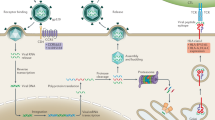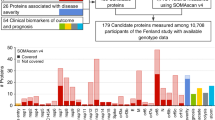Abstract
MPYS, also known as STING and MITA, is an interferon (IFN)β stimulator essential for host defense against RNA, DNA viruses and intracellular bacteria. MPYS also facilitates the adjuvant activity of DNA vaccines. Here, we report identification of a distinct human MPYS haplotype that contains three non-synonymous single nucleotide polymorphisms (SNPs), R71H-G230A-R293Q (thus, named the HAQ haplotype). We estimate, in two cohorts (1074 individuals), that ∼3% of Americans are homozygous for this HAQ haplotype. HAQ MPYS exhibits a >90% loss in the ability to stimulate IFNβ production. Furthermore, fibroblasts and macrophage cells expressing HAQ are defective in Listeria monocytogenes infection-induced IFNβ production. Lastly, we find that the loss of IFNβ activity is due primarily to the R71H and R293Q SNPs in HAQ. We hypothesize that individuals carrying HAQ may exhibit heightened susceptibility to viral infection and respond poorly to DNA vaccines.
This is a preview of subscription content, access via your institution
Access options
Subscribe to this journal
Receive 6 digital issues and online access to articles
$119.00 per year
only $19.83 per issue
Buy this article
- Purchase on Springer Link
- Instant access to full article PDF
Prices may be subject to local taxes which are calculated during checkout





Similar content being viewed by others
References
Cook DN, Pisetsky DS, Schwartz DA . Toll-like receptors in the pathogenesis of human disease. Nat Immunol 2004; 5: 975–979.
Arbour NC, Lorenz E, Schutte BC, Zabner J, Kline JN, Jones M et al. TLR4 mutations are associated with endotoxin hyporesponsiveness in humans. Nat Genet 2000; 25: 187–191.
Lorenz E, Mira JP, Frees KL, Schwartz DA . Relevance of mutations in the TLR4 receptor in patients with gram-negative septic shock. Arch Intern Med 2002; 162: 1028–1032.
Shigemoto T, Kageyama M, Hirai R, Zheng J, Yoneyama M, Fujita T . Identification of loss of function mutations in human genes encoding RIG-I and MDA5: implications for resistance to type I diabetes. J Biol Chem 2009; 284: 13348–13354.
Jin L, Waterman PM, Jonscher KR, Short CM, Reisdorph NA, Cambier JC . MPYS, a novel membrane tetraspanner, is associated with major histocompatibility complex class II and mediates transduction of apoptotic signals. Mol Cell Biol 2008; 28: 5014–5026.
Ishikawa H, Barber GN . STING is an endoplasmic reticulum adaptor that facilitates innate immune signalling. Nature 2008; 455: 674–678.
Ishikawa H, Ma Z, Barber GN . STING regulates intracellular DNA-mediated, type I interferon-dependent innate immunity. Nature 2009; 461: 788–792.
Zhong B, Yang Y, Li S, Wang YY, Li Y, Diao F et al. The adaptor protein MITA links virus-sensing receptors to IRF3 transcription factor activation. Immunity 2008; 29: 538–550.
Sun W, Li Y, Chen L, Chen H, You F, Zhou X et al. ERIS, an endoplasmic reticulum IFN stimulator, activates innate immune signaling through dimerization. Proc Natl Acad Sci USA 2009; 106: 8653–8658.
Kortemme T, Darby NJ, Creighton TE . Electrostatic interactions in the active site of the N-terminal thioredoxin-like domain of protein disulfide isomerase. Biochemistry 1996; 35: 14503–14511.
O’Connell RM, Saha SK, Vaidya SA, Bruhn KW, Miranda GA, Zarnegar B et al. Type I interferon production enhances susceptibility to Listeria monocytogenes infection. J Exp Med 2004; 200: 437–445.
Bin LH, Xu LG, Shu HB . TIRP, a novel Toll/interleukin-1 receptor (TIR) domain-containing adapter protein involved in TIR signaling. J Biol Chem 2003; 278: 24526–24532.
Xu LG, Wang YY, Han KJ, Li LY, Zhai Z, Shu HB . VISA is an adapter protein required for virus-triggered IFN-beta signaling. Mol Cell 2005; 19: 727–740.
Rayamajhi M, Humann J, Penheiter K, Andreasen K, Lenz LL . Induction of IFN-alphabeta enables Listeria monocytogenes to suppress macrophage activation by IFN-gamma. J Exp Med 2010; 207: 327–337.
Acknowledgements
This work was supported by NIH 3R01AI062739-05S209 (JCC), 5R01AI062739-05 (JCC), HL089807-01 (MMW) and NIH U19 ES11375 (DAS and IVY) JCC is Ida and Cecil Green Professor of Immunology. We thank Dr Barber GN for providing STING−/− Femurs. For the human studies, we gratefully acknowledge all participants.
Author information
Authors and Affiliations
Corresponding author
Ethics declarations
Competing interests
The authors declare no conflict of interest.
Additional information
Supplementary Information accompanies the paper on Genes and Immunity website
Supplementary information
Rights and permissions
About this article
Cite this article
Jin, L., Xu, Lg., Yang, I. et al. Identification and characterization of a loss-of-function human MPYS variant. Genes Immun 12, 263–269 (2011). https://doi.org/10.1038/gene.2010.75
Received:
Accepted:
Published:
Issue Date:
DOI: https://doi.org/10.1038/gene.2010.75
Keywords
This article is cited by
-
The common H232 STING allele shows impaired activities in DNA sensing, susceptibility to viral infection, and in monocyte cell function, while the HAQ variant possesses wild-type properties
Scientific Reports (2023)
-
Prolonged activation of innate immune pathways by a polyvalent STING agonist
Nature Biomedical Engineering (2021)
-
TMEM173 variants and potential importance to human biology and disease
Genes & Immunity (2019)
-
T cell fate following Salmonella infection is determined by a STING-IRF1 signaling axis in mice
Communications Biology (2019)
-
Stimulator of interferon genes (STING) activation exacerbates experimental colitis in mice
Scientific Reports (2019)



